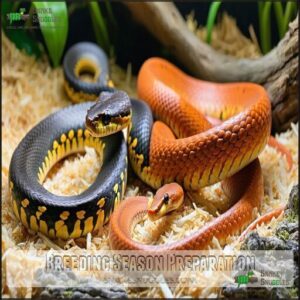This site is supported by our readers. We may earn a commission, at no cost to you, if you purchase through links.
 Choosing the right mate for your snake requires attention to their health, age, and species compatibility.
Choosing the right mate for your snake requires attention to their health, age, and species compatibility.
Start by ensuring both snakes are disease-free, mature, and at an ideal weight. Species matters—a ball python needs another ball python, not a corn snake.
Look for strong genetic traits to avoid inherited issues, and keep size differences minimal to prevent injuries. When introducing them, place the female in the male’s enclosure to encourage natural courtship behaviors.
Monitor closely, as snakes can have their quirks during mating. A stress-free environment with perfect temperature and humidity seals the deal.
The result? Healthy hatchlings and happy reptiles!
Table Of Contents
- Key Takeaways
- Choosing Healthy Snakes
- Snake Mating Behaviors
- Mate Selection Criteria
- Snake Reproduction Basics
- Female Snake Preferences
- Male Snake Characteristics
- Snake Breeding Environment
- Breeding Season Preparation
- Snake Compatibility
- Successful Mating Outcomes
- Frequently Asked Questions (FAQs)
- How do I choose a mate for my pet snake?
- How do I choose the best snakes to breed?
- How do I Make my snakes mate?
- How do you handle a snake during mating season?
- How do you know if a snake is mating?
- Is snake breeding a good idea?
- How do snakes choose mates?
- What kind of snake is right for me?
- Do snakes have a favorite person?
- Do snakes like to be in pairs?
- Conclusion
Key Takeaways
- Make sure both snakes are healthy and disease-free, and mature before introducing them for breeding.
- Only pair snakes of the same species to ensure compatibility and avoid issues during courtship.
- Create a stress-free environment with proper temperature, humidity, and hiding spots to encourage natural mating behaviors.
- Choose mates with strong genetic traits and minimal size differences to promote healthy offspring and reduce risks.
Choosing Healthy Snakes
When choosing a mate for your snake, start by verifying both candidates are healthy, disease-free, and in peak condition. This improves breeding success as well as guarantees strong, viable offspring.
Verify your snakes’ health and fitness to ensure strong, healthy offspring and a successful breeding process.
Evaluating Male Traits
When evaluating male traits for mate selection, focus on size assessment, strength display, and overall reproductive fitness.
Observe health indicators and vigor showcases during mating competition, as these reflect genetic quality.
Look for males exhibiting robust genetic markers and physical fitness, ensuring their offspring will thrive.
Remember, strong, healthy males pass on superior traits that enhance survival chances.
Selecting Snakes Free From Disease
Spotting disease-free snakes is essential for healthy breeding.
Check for mites, clean vents, and absence of wheezing or mucus. Use disease screening and quarantine protocols to prevent parasite transmission.
Examine snakes for genetic predisposition to illnesses. Preventative measures, like routine health checks, boost success.
Prioritize snake health—it’s imperative when choosing a suitable mate for strong offspring and effective genetics during breeding, ensuring healthy breeding.
Identifying Healthy Females
When choosing a snake mate, you’ll want to verify the female is in top shape.
Start with a physical examination to check for injuries or parasites. Review her reproductive history for consistent breeding success. Pay attention to behavioral cues like active feeding and movement.
- Watch for: Clear, bright eyes and smooth scales.
- Avoid: Lethargy, unusual aggression, or poor appetite.
- Always: Follow a quarantine period to confirm overall snake health.
Snake Mating Behaviors
In the context of snake breeding, understanding their mating behaviors is essential for success. Snakes use pheromone trails, combat rituals, and unique courtship displays to find and secure a mate.
Pheromone Trails
A snake’s pheromones act like a signature perfume, guiding potential mates through their Scent Trail Composition.
Following Pheromones, males rely on their Vomeronasal System for navigation.
However, Trail Degradation can occur over time, complicating mate selection.
Here’s a quick breakdown:
| Key Element | Role | Challenge |
|---|---|---|
| Chemical Signaling | Attracting males | Fading signals |
| Scent Trail | Locating females | Disrupted paths |
| Species Specificity | Guarantees compatibility | Mixed trails |
| Vomeronasal System | Detect pheromones | Intensity loss |
Mate Selection Process
Understanding pheromone trails sets the stage for the mate selection process.
Female snakes rely on behavioral signals and sensory evaluation to assess males. Initial assessment considers size, strength, and health, while genetic screening helps measure compatibility factors.
Successful mate selection guarantees healthy, strong offspring.
- Key elements in mate selection:
- Size and health of males.
- Compatibility factors.
- Behavioral signals of readiness.
- Scent-based sensory evaluation.
Mating Balls Formation
During snake mating, males compete in intense "mating balls," where up to 100 males vie for one female.
Mating balls are chaotic displays of nature, where strength, persistence, and pheromones fuel the competition for a single female.
It’s a chaotic yet fascinating dance driven by pheromone influence and mate choice.
Dominance displays, like combat and wrapping tactics, decide the victor.
Female choice often plays a role in this snake courtship.
| Behavior | Purpose | Traits Involved | Outcome |
|---|---|---|---|
| Pheromone Trails | Attract males | Chemical signaling | Males locate females |
| Ball Dynamics | Male competition | Strength, persistence | Dominant mate emerges |
| Dominance Displays | Fight for access | Physical combat | Strongest male wins |
| Female Choice | Maximizing genetics | Evaluating traits | Chooses preferred mate |
Mate Selection Criteria
When choosing a mate for your snake, focus on factors like size, strength, and overall health to guarantee successful breeding.
Evaluating genetic quality and vigor helps promote healthy offspring and strengthens breeding outcomes.
Size and Strength
Male dominance often stems from size and strength, two factors that heavily influence female assessment during mating.
Larger males with physical prowess and combat advantages display brute force through physical contests, ensuring offspring survival by passing on superior genes.
These physical displays highlight a snake’s readiness and reinforce snake compatibility, making size a key consideration when choosing a snake mate.
Genetic Quality
Strength matters, but genetic quality plays a bigger role in snake breeding.
Prioritize mates with strong lineage purity to reduce mutation risks. Ensuring genetic diversity boosts offspring health and compatibility.
Snakes inherit traits like size and color through selective mate choice, so evaluate genetics carefully.
Healthy lineages create robust snakes, highlighting why understanding snake genetics is key for successful mate selection.
Health and Vigor
When choosing a snake mate, focus on physical condition and disease resistance.
A healthy snake with strong activity levels and excellent nutritional status signals health, essential for breeding success.
Snake genetics and genetic health also play a role in producing robust offspring.
Prioritize healthy snake breeding to guarantee superior genetic quality and avoid complications in reproduction.
Snake Reproduction Basics
Snake reproduction involves two primary methods: oviparity, where eggs are laid, and viviparity, where live young are born.
Understanding these basics helps you create the right conditions for a successful breeding process.
Oviparity and Viviparity
Snake reproduction involves two main strategies: oviparity (egg-laying) and viviparity (live birth).
Oviparous snakes rely on external egg incubation, while viviparous species develop embryos internally.
These reproductive strategies depend on species variation.
Key differences include:
- Parental investment: Minimal in either case.
- Embryo development: Inside or outside.
- Climate preferences: Cold favors live birth.
- Egg-protection needs: Higher for oviparity.
Gestation Period
Snake gestation periods, often spanning 28 to 45 days, vary by species.
Factors affecting this include gestation length, nutritional needs, and environmental impact.
A well-fed, stress-free snake experiences smoother pregnancies.
Be vigilant during snake reproduction, since mother snakes require stable conditions and care.
Proper temperature and humidity help support healthy development, ensuring successful outcomes in snake mating and pregnancy.
Birth and Post-Birth Care
After birth, baby snakes are fully independent, relying on instincts to survive without parental care. Verify proper incubation during snake pregnancy, as neonate health starts there.
Post-birth feeding is vital—start with appropriately sized prey. Watch for signs of illness or dehydration.
- Verify the enclosure is escape-proof and safe.
- Provide consistent humidity for snake hatchlings.
- Monitor temperature during snake egg incubation, which is crucial for the health of the neonate snakes, and ensure proper care is given.
Female Snake Preferences
Female snakes rely on sensory cues and behavioral observations to assess potential mates, focusing on traits like size, strength, and health.
By choosing genetically compatible partners, they maximize their chances of producing strong, viable offspring.
Sensory Cues
Female snakes use pheromone signaling to attract mates, creating a scent trail males follow using their Jacobson’s organ.
Males detect readiness by interpreting these chemical signals, often prioritizing females through sensory biases.
Visual assessment sometimes supports pheromone cues, while tactile courtship behaviors add complexity.
Environmental factors like humidity can influence scent strength, guiding males even further.
Snakes use their forked tongue sensory capabilities to sample chemical gradients.
Behavioral Observations
When observing courtship behavior, notice how males use courtship displays to attract females.
Females scrutinize these actions, evaluating strength and health.
- Look for vigorous displays like lekking behavior or combat dances.
- Watch for sensory biases favoring specific traits.
- Note post-mating hostility signs for compatibility insight.
- Be aware of subtle snake mating rituals indicating mate attraction success.
Genetic Compatibility
When choosing your snake’s mate, pay attention to genetic diversity to avoid inbreeding.
Inbreeding can lead to health issues by limiting allele frequencies, affecting disease resistance and survival.
Hybridization risks also arise if species aren’t matched correctly.
A well-matched pair strengthens snake reproduction success.
Careful snake genetics planning guarantees healthier offspring and supports the long-term health of snake breeding programs.
Male Snake Characteristics
When selecting a male snake for breeding, it’s essential to assess their unique traits like hemipenes structure, courtship rituals, and combat behavior.
These characteristics directly impact fertility, mating success, and overall compatibility with the female.
Hemipenes Structure
Did you know male snakes have two hemipenes? These specialized organs, often featuring spikes and hooks, play a key role in snake reproduction.
Stored inside the tail, they’re used alternately during mating, showcasing functional asymmetry. Hemipenes morphology varies across species, influencing snake anatomy and mating success.
Sometimes, a mating plug forms, ensuring paternity while highlighting the evolutionary significance of this unique structure.
Courtship Rituals
Male snakes use fascinating courtship rituals to woo potential mates.
Their behaviors often include chin-rubbing and tail quivering, both driven by pheromone signals. Coital biting is common during reptile mating, securing connection.
Snake mating behavior also features combat dances to outshine rivals. Mating balls are a fascinating spectacle.
- Chin-Rubbing: Gentle tactile communication.
- Tail Quivering: A rhythmic display of intention.
- Coital Biting: Secures stability during mating.
- Pheromone Signals: Key to attraction.
- Combat Dances: Displays dominance.
Combat Behavior
Physical altercations like combat dances showcase dominance displays among male snakes during mating.
These contests, resembling wrestling, determine the strongest male to compete for females in mating balls.
Rivalry intensity often peaks with males toppling or body-bridging to outmatch rivals.
Such snake dominance displays guarantee only the fittest mate, ultimately contributing strength and resilience to the next generation.
Snake Breeding Environment
Creating the perfect breeding environment for your snakes means managing temperature, humidity, and lighting carefully to mimic their natural habitat.
Make sure the enclosure is spacious, secure, and equipped with proper ventilation for maximum comfort and health.
Temperature and Humidity
After understanding male snake behaviors, focus on maintaining the right breeding environment.
Temperature control and proper humidity levels are essential for snake comfort.
- Optimal Ranges: Keep temperatures between 75-85°F and humidity at 50-70%.
- Gradient Creation: Provide warm and cool zones for thermoregulation.
- Humidity Methods: Use water bowls or misting systems for steady levels.
Effective monitoring tools guarantee ideal conditions.
Many owners utilize specialized heating products to maintain proper temperatures.
Enclosure Setup
Setting up a breeding enclosure involves careful planning. Use the right tank size, a proper substrate, and provide cozy hiding spots.
Maintain a thermal gradient for temperature control and guarantee ventilation needs are met. A conducive environment supports healthy breeding behavior.
You can find suitable items for complete snake habitats online.
| Aspect | Recommendation | Purpose |
|---|---|---|
| Size Requirements | Large enough for both snakes | Comfort and space for mating |
| Substrate Choice | Soft, non-toxic material | Simulates natural environment |
| Hiding Spots | Multiple, secure areas | Reduces stress during breeding |
| Thermal Gradient | Warm and cool zones | Regulates body temperature |
| Ventilation Needs | Adequate airflow | Prevents mold and guarantees fresh air |
Lighting and Ventilation
Proper lighting and ventilation keep your snake breeding enclosure healthy.
Use a light spectrum mimicking natural rhythms to support activity and rest cycles. Ventilation methods help stabilize temperature control and humidity levels, preventing an overly damp setup.
Add basking spots for warmth, ensuring a conducive environment. Combined, these factors promote comfort and successful snake breeding environment control for your slithery friends, which is essential for a healthy environment.
Breeding Season Preparation
Preparing for the breeding season involves ensuring your snakes are healthy, well-fed, and ready for mating.
Focus on proper brumation, a nutrition-rich diet, and thorough health checks to set the stage for successful reproduction.
Brumation Process
Brumation prepares snakes for mating season by mimicking winter conditions.
Gradually lower temperatures while maintaining humidity control to prevent dehydration. Pre-brumation feeding guarantees energy reserves, as they won’t eat during this period.
Brumation length depends on the species, usually lasting a few weeks to months.
Afterward, post-brumation care involves gradually warming them and monitoring for health before choosing a snake mate, which is crucial for the mating season.
Nutrition and Diet
A protein-rich diet is essential for snake breeding nutrition.
During the breeding season, adjust the feeding schedule to account for seasonal feeding changes. Offer appropriately sized prey to match the snake’s nutritional needs, and consider supplementation needs for a balanced diet.
Don’t forget hydration importance—always provide fresh water. A healthy breeding diet guarantees energy and supports successful reproduction.
Calcium supplementation is often needed to achieve the ideal calcium-to-phosphorus ratio.
Health Checks
A quick health check is essential when choosing a suitable mate for your snake.
Follow these basics:
- Screen for parasites to guarantee no hidden issues.
- Implement quarantine protocols for new additions.
- Conduct a thorough physical examination for visible concerns.
- Use genetic testing to avoid hereditary problems.
- Perform a behavioral assessment to monitor snake health and compatibility.
Thorough checks guarantee safe, successful breeding! Regular testing can help with snake parasite detection.
This process ensures that you are taking the necessary steps to protect your snake’s overall health and well-being, and to prevent the introduction of harmful parasites or genetic issues into your breeding program, which is crucial for responsible breeding.
Snake Compatibility
Choosing the right mate for your snake starts with understanding species-specific traits, age, and size.
You’ll also need to evaluate genetic diversity in order to guarantee healthy offspring and successful breeding.
Species-Specific Traits
Snake species vary in morphological differences, behavioral nuances, and reproductive strategies, so choosing the right mate requires understanding these traits.
For successful snake mating, consult a snake sexing chart and consider their genetic markers and dietary needs.
Here’s a quick reference:
| Trait | Male Snakes | Female Snakes |
|---|---|---|
| Tail Shape | Longer, tapered | Shorter, blunt |
| Mating Behavior | Active search | Emits pheromones |
| Reproductive Timing | Seasonal readiness | Sperm storage ability |
Age and Size Considerations
When choosing a suitable mate, pay close attention to breeding age and size maturity.
Males and females should have reached sexual maturity, as growth rates and age variance affect successful snake breeding.
Larger snakes aren’t always better; compatibility matters more.
Assess if your snake is ready for mating by their growth and age milestones, ensuring healthy snake mating outcomes.
Genetic Diversity
To guarantee healthy snake reproduction, focus on genetic diversity. Inbreeding risks, like defects and higher mutation rates, can threaten offspring.
Prioritize unrelated mates to encourage hybrid vigor and strong gene flow. Consider species-specific traits for conservation genetics.
Choosing snake mates carefully prevents snake inbreeding issues while boosting adaptability. Diverse genetics safeguard future generations and enhance successful snake breeding outcomes.
Successful Mating Outcomes
To achieve successful mating outcomes, you’ll need to focus on ensuring proper fertilization and healthy egg development.
Careful monitoring of the female’s condition post-mating helps secure the health of both the mother and the future hatchlings, which is crucial for healthy egg development.
Fertilization and Egg Development
When pairing snakes, fertilization occurs as the male inserts one hemipenis into the female’s cloaca, releasing sperm.
Females can store sperm for flexible timing.
Depending on the species, reproduction leads to oviparity or viviparity.
Eggshell formation begins post-fertilization, preparing for incubation.
The gestation period varies, with snake egg development showcasing nature’s evolutionary brilliance, ensuring offspring readiness.
Birth and Hatchling Care
Once eggs hatch or live young arrive, baby snakes tackle life solo, showcasing hatchling independence.
Set up a safe enclosure with proper warmth and humidity.
Offer tiny prey to match their size, sticking to a consistent feeding schedule. Watch for their first shed and monitor for common ailments like dehydration.
Providing optimal humidity levels is essential for their well-being.
Snake reproduction is fascinating, but healthy beginnings matter most.
Post-Mating Health Checks
Once your snake has successfully mated, keep an eye on its health.
Regular checks matter for comfort and recovery.
Pay attention to:
- Weight Monitoring: Watch for unusual loss or gain.
- Appetite Changes: Reduced feeding might signal stress.
- Injury Assessment: Spot bites or abrasions from courtship.
- Parasite Control: Fungal infections may arise post-contact.
Monitoring snake health guarantees smooth reproduction success.
Frequently Asked Questions (FAQs)
How do I choose a mate for my pet snake?
Finding the perfect mate for your snake isn’t rocket science, but it’s essential.
Choose a healthy, same-species partner, make certain they’re mature and disease-free, and create a stress-free, comfy setup for successful breeding.
How do I choose the best snakes to breed?
Choose snakes based on health, species compatibility, age, and breeding readiness.
Look for traits like strength, vibrant coloration, and good temperament.
Verify that both are disease-free, properly fed, and kept in ideal environmental conditions, ensuring they have good temperament.
How do I Make my snakes mate?
Think of it like orchestrating a dance.
Create a calm, temperature-controlled space with proper humidity, pair healthy snakes of the same species, and let nature take over.
Patience and close observation are key.
How do you handle a snake during mating season?
Handle your snake gently during mating season.
Support its body, avoid sudden movements, and respect its behavior.
Minimize stress with a calm environment, maintaining proper temperature and humidity.
Always observe closely to prevent injuries or conflicts, and remember to handle your snake with care in a calm environment.
How do you know if a snake is mating?
It’s like a snake soap opera—males twist and wrestle in a “mating ball,” vying for the female’s attention.
You’ll see chin-rubbing, tail-quivering, and body wrapping—clear signs they’re getting romantic!
Is snake breeding a good idea?
Breeding snakes can be rewarding if you’re prepared for the responsibility.
It requires proper knowledge, space, and resources.
Without careful planning, you risk overpopulation or health issues.
Make sure you’re committed before diving in.
How do snakes choose mates?
Snakes choose mates through a mix of pheromone signals, size, strength, and genetic quality.
Females release chemical trails, attracting males who compete physically, ensuring only the strongest or most compatible male earns the chance to reproduce, based on genetic quality.
What kind of snake is right for me?
Pick a snake that fits your experience level, living space, and commitment.
Ball pythons are great for beginners, while corn snakes are low-maintenance.
Verify the species matches your care ability and enclosure setup.
Do snakes have a favorite person?
Snakes don’t form personal bonds like people or pets do.
They recognize environmental cues and patterns instead.
If you meet their care needs consistently, they may seem calmer, but it’s not personal affection.
Do snakes like to be in pairs?
Only around 5% of reptiles, including some snakes, form social bonds.
Most snakes prefer solitude, thriving alone rather than in pairs.
Forcing cohabitation often leads to stress, competition, or aggression, especially outside of mating season, which can be a significant issue for snakes.
Conclusion
Think of your snake’s mate as the key to revealing the future of healthy, vibrant hatchlings.
By focusing on health, species compatibility, and strong genetic traits, you’re setting the stage for successful breeding.
Pay attention to size, age, and temperament to guarantee harmony during courtship.
Providing the right environment with ideal temperature and humidity helps seal the bond.
Choosing the right mate for your snake isn’t just about pairing—it’s about building a strong foundation for the generations ahead, based on successful breeding.




















